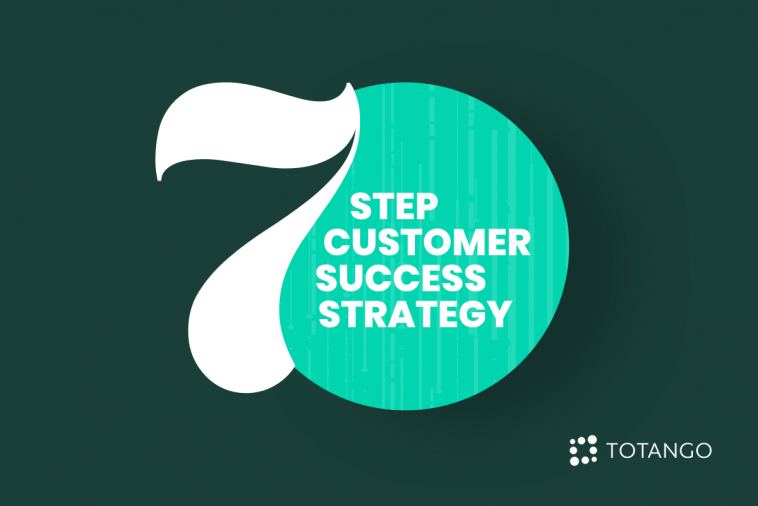- Like
- SHARE
- Digg
- Del
- Tumblr
- VKontakte
- Flattr
- Buffer
- Love This
- Save
- Odnoklassniki
- Meneame
- Blogger
- Amazon
- Yahoo Mail
- Gmail
- AOL
- Newsvine
- HackerNews
- Evernote
- MySpace
- Mail.ru
- Viadeo
- Line
- Comments
- Yummly
- SMS
- Viber
- Telegram
- JOIN
- Skype
- Facebook Messenger
- Kakao
- LiveJournal
- Yammer
- Edgar
- Fintel
- Mix
- Instapaper
- Copy Link
A customer success strategy is a proactive plan for guiding your clients to outcomes that satisfy their needs. When your customers enjoy more value, your product adoption rates rise and customer retention rates go up. This promotes success for your company as well as your customers.
In this guide, we’ll lay out a seven-step customer success strategy you can use to promote winning outcomes for your clients:
- Prioritize a culture of customer success
- Set success goals for each stage of your customer journey map
- Make onboarding easy
- Segment your customer database for personalized communications
- Proactively guide customer growth
- Incorporate customer feedback
- Automate your customer success strategy with customer success software
Use these methods to promote greater success for your customers and better results for your business.
1. Prioritize a Culture of Customer Success
An environment that nourishes customer success starts with your company culture. When you place a priority on customer success, your commitment radiates through your policies and practices. This directs your staff to take the steps necessary to help your customers succeed.
You can take a number of steps to build a culture that promotes customer success:
- Incorporate customer success into your company’s mission statement, verbalizing how your corporate purpose aligns with helping to achieve not only customers’ goals but your employee’s goals.
- Build customer success into your policy statement, articulating how your guiding principles support the success of your customers. (“We invest in improving our apps to reduce the number of steps involved in lead generation.”)
- Define your workflow processes so that they relate to customer success. (“We track our customers’ use of our features through the onboarding and adoption process in order to identify places where we could eliminate unnecessary steps to simplify user experience.”)
- Develop standard operating procedures that support customer success goals. (“To track customer onboarding and adoption, we use a three-step procedure. . .”)
- Set organizational goals that help your staff see the value in prioritizing customer success.
Taking steps such as these will help you build a commitment to customer success into your culture, your policies, and your procedures. This will guide your employees to take steps that promote customer success, generating results that yield higher customer retention.
2. Set Success Goals for Each Stage of Your Customer Journey Map
To put your goals of promoting customer success into action, you can define benchmarks that measure success in quantifiable terms. A great way to do this is to create a customer journey map.
A customer journey map lays out the stages in your customers’ interactions with your brand, from the time you acquire them as a lead to the time they either become a repeat buyer or decide to end their relationship with you. The stages in a customer journey map include:
- Lead acquisition: the steps by which a prospect becomes aware of your brand and enters your customer relationship management database (for example, seeing an ad that leads them to visit your site, read your blog and join your email list)
- Lead conversion: the decision-making process which converts a prospect into a buyer (such as signing up for a free trial of a SaaS product)
- Onboarding: actions your customer takes after purchase to become an active user of your product or service (such as activating their SaaS account and setting up their profile)
- Adoption: actions your customer takes which promote increased use of their purchase (such as learning advanced features of a SaaS app)
- Escalation: the steps your customer experiences when they encounter a problem using your product and attempt to contact you for support (such as visiting your website to seek help from an agent)
- Renewal: the process by which a customer decides to purchase from you again or let their relationship with you lapse (such as the decision whether or not to renew a SaaS subscription)
At each of these steps, you can define outcomes that represent a successful experience for your customer, as well as opposing outcomes that represent failure. For example, during the onboarding stage, completing account set-up within a week of purchase might represent success, while failing to do so within this time frame might represent failure.
Defining desired outcomes enables you to establish benchmarks that can be used to measure customer success. Use customizable stages throughout onboarding to ensure that your customers are meeting their anticipated goals.
This approach allows you to quantify customer success. You can then use automated tracking to see at a glance how individual customers are succeeding at achieving their goals with your brand. You can also view trends among groups of customers or your entire customer database for a broader understanding of how well your product is promoting customer success and where it may be falling short. In addition, you can automate your playbooks to help course correct in real-time and drive value to customers at the proper time.
3. Make Onboarding Easy
To promote retention, one of the most important places to support a successful experience is during the customer onboarding process. When customers complete your onboarding process quickly and easily, they begin deriving value from your product more rapidly, increasing their incentive for continued use. In contrast, delays in the onboarding process may generate dissatisfaction and deter continued usage, or even prompt a request for a refund.
You can promote a smoother, more successful onboarding experience by automating your onboarding process. Some of the things you can do when you automate your onboarding experience include:
- Track and score customer progress during the onboarding process to ensure that each user enjoys a successful experience
- Segment your customers based on where they are in the onboarding process and what support they need to reach the next stage of their journey
- View reports to see how customers are faring at completing your onboarding process and where snags are occurring
- Set up automated sequences of tasks and actions (SuccessPlays) triggered by events in your customers’ experience (for example, if a customer’s satisfaction score reaches an exceptionally low level, this can alert your customer support team to intervene)
- Send out automated messages based on customers’ progress towards success benchmarks (for instance, sending a welcome message when a new user registers)
These types of automated features can help you promote more consistently successful outcomes during the onboarding stage of your customers’ journey.
4. Segment Your Customer Database for Personalized Communications
Your ability to guide customers through a successful experience at each stage in their journey depends on the quality of your communication with them. You can improve the quality of your communication by connecting all your customer data in one place, like in a customer success solution, and segmenting your customers based on specific criteria to deliver more personalized messaging.
Customer segmentation divides your customer contact database into subunits based on the criteria you choose. One way to segment your list is based on actions a customer has taken. For example, you can divide your list into all customers who have completed their onboarding process within seven days of purchase and all those who have not. You can then set up an automated email to go out only to that list segment that has not completed onboarding within the designated time frame.
You can also segment your customers by attributes. For example, you might segregate all customers who have five or more users on their account. You can then send content to that customer segment providing advice on how to manage their team’s use of your app. This type of segmentation can also be useful for promoting an upsell product to customers on your list who meet specific qualifying criteria.
Segmentation is a powerful tool for promoting customer success outcomes. You can deliver hyper-targeted messages to micro-segments of your list, allowing you to provide the right touch at the right time.
5. Proactively Promote Customer Growth
During the onboarding and adoption stages, customer success depends on your ongoing support. You can provide better support by creating meaningful content geared towards the needs of customers at each stage in their journey with your product.
Content supporting customer success can include:
- FAQ guides
- Tutorials
- Demonstrations
- Blog posts with tips addressing common concerns
- Emails
To ensure that customers put your content to practical use, be proactive in reaching out to them. Use automated tracking to identify when customers have reached a point in their journey where a particular piece of content would be useful to them. Set up automated SuccessPlay routines to promote content to customer segments in need of support content. For instance, you can set up a SuccessPlay so that, when a customer begins completing their account profile, they receive messaging advising them how to complete the next step. Anticipating customer needs in this way can help you promote a more successful customer journey.
6. Incorporate Customer Feedback
Ultimately, the performance of your customer success strategy is measured by whether your customers feel that your brand has helped them achieve their goals.
You can use a number of methods to collect feedback from your customers. One is to survey customers occasionally about how likely they are to promote you to a friend or colleague. You can quantify this by using a Net Promoter Score (NPS) system, which asks customers to express their answer on a scale of 0 to 10, with 10 representing a customer being extremely likely to promote you.
A similar method is measuring customer satisfaction (CSAT). To do this, you ask customers to rate how satisfied they were with some aspect of their experience with you. For example, after a customer has received support from one of your agents, you might ask them to rate how satisfied they with different aspects of their experience, such as their satisfaction with how helpful your agent was.
For best results, create standard operating procedures for collecting customer feedback at key points in their journey, and use automated tools to implement your procedures. Examples of strategic points to collect feedback include:
- After a customer has completed their onboarding process and had sufficient time to begin using your product
- After a customer has completed a major milestone
- If a customer hasn’t been active for X days
- As the time approaches for a customer to renew a subscription or license
You can set up automated procedures for eliciting customer feedback at key points in your customers’ journey.
7. Automate Your Customer Success Strategy with Customer Success Software
Your customer success strategy will work best when supported by complementary technology. An ideal customer success software solution should help you automate the steps in your customer success strategy for more efficient execution and more consistent results throughout your customer journey.
An optimal solution should include a number of key features:
- Ability to define and track measurable success goals aligned with your customer journey map
- Real-time monitoring of customer progress towards success goals
- Customer database segmentation tools allowing you to customize communications and workflows for groups of customers or individual users
- Configurable best practices, scorecards, and communication templates
- A customer data platform that connects all of your data in one place
- Customer health scoring
- Customizable and automated playbooks
You can attempt to assemble these features with precision and agility from multiple apps, or you can look for an all-in-one solution that combines all these elements into one handy interface. We’ve designed Totango’s solutions to cover all these bases to support all components of your customer success strategy.
Execute a Winning Customer Success Strategy to Elevate Your Company’s Success
When your customers succeed, you succeed. Following the strategy laid out in this guide will help you steer your customers and your company towards mutual success.
Prioritizing a culture of customer success positions you to provide value at scale at every stage of their journey. Segmenting your database allows you to personalize communications to make them relevant to your customers wherever they are in their journey. This helps you guide your customers through a smoother onboarding process and support them through sustained growth, making renewals exciting for the customer. Incorporating feedback from your customers helps ensure that your success strategy is working for them.
Choosing the right customer success software solution can help you implement your customer success strategy more efficiently. The Totango Spark platform is specifically designed to help you achieve your enterprise’s customer success goals. View a live demo of how our platform works, or get started for free with ready-made toolkits designed for each stage of the customer journey.



